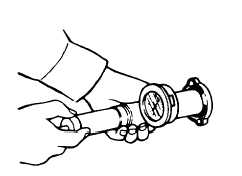| |
TM 10-3930-653-14&P
Standard type
Frigid type
Valve opening
Temperature
76.5 (170)
88 (190)
C ( F)
Maximum valve
lift mm/°C
8/90 (0.31/194)
7/1100(0.28/212)
(in/ F)
4-4-3-4. RADIATOR
The radiator is a conventional cross flow type having
right and left tanks to distribute the coolant flow uniformly
through the horizontal tubes of the radiator's core.
The radiator filler cap is designed to maintain a pre-
set pressure 0.9 kg/cm2 (13 psi) above atmospheric
pressure. The relief valve consisting of a blow-off valve
and a vacuum valve, helps to prevent coolant loss from
boiling by raising the pressure on the coolant. On the
other hand as the pressure is reduced below
atmospheric pressure the vacuum valve allows air to re-
enter the radiator, preventing the formation of a vacuum
in the cooling system.
The left tank on lift trucks equipped with an
automatic transmission incorporates an oil cooler for the
transmission fluid.
(1) REMOVAL AND INSTALLATION
(1) Drain coolant into a clean container.
(2) Remove top panel.
(3) Remove engine hood.
(4) Disconnect radiator upper and lower hoses. On
models with automatic transmission, disconnect cooler
inlet and outlet lines from radiator.
(5) If equipped, remove radiator shroud retaining bolts
and remove radiator shroud.
(6) Remove radiator retaining bolts and then remove
radiator upward.
(7) Install radiator in the reverse sequence of removal.
Note the following:
a. Insert hoses in their positions until they bottom.
b. Ensure that arrow marks on hoses are clearly
visible from above when hoses are assembled.
c. Ensure that clearance between shroud and fan
is even.
Note:
Be careful not to damage radiator fins
and core tubes when installing.
(2) INSPECTION
Radiator cap should be checked for working
pressure at regular tune-up intervals. First, check rubber
seal on cap for tears, cracks or deterioration after
cleaning it. Then, install radiator cap on a tester. If cap
does not hold or will not release at the specified
pressure, replace cap.
Fig. 4-114. Testing Radiator Cap.
Also, inspect radiator for leakage using cap tester
and applying a pressure of 1.6 kg/cm2 (23 psi).
If leakage is detected, repair or replace radiator.
4-60
|

